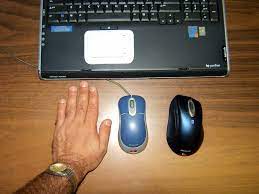The Optical Bluetooth Mouse is the most convenient computer mouse for laptop computers and can make use of a laptops built-in Bluetooth transmitter or a tiny plug-in dongle. Before the Bluetooth mouse became available, there had been a long history of computer mouse development. In this article you will read a history of how the Bluetooth Mouse evolved from the very first computer mouse to its current format and how it has overcome so many of the frustrations we experienced with earlier generation mice.
The First Computer Mouse
The first computer mouse was born in 1963. It was invented by Douglas Englebart and Bill English. It was constructed from a block of woos and a metal wheel which turned as it was pushed over the surface of a desk. It was extremely unreliable and was not commercialised.
It took almost 9 years before the first mouse to see commercial success was created. This was also invented by English and was know as the roller ball mouse. Instead of wheels, this mouse made use of a central ball that rotated freely in a socket as the mouse was pushed in any direction over a surface. Tiny rollers in contact with the ball would translate movements in the X and Y directions into electrical signals which were converted by software in the computer to corresponding movements of the cursor. The early versions had only one clickable button for communicating with the computer.
One huge frustration with the roller ball mice was their propensity to pick up dust and grease which would eventually clog up the rollers and would require a thorough cleaning to remove; a very tedious procedure. Despite this, roller ball mice are still available commercially, which must make them one of the longest lasting of all modern electronic gadgets.
The basic roller ball mouse evolved through time as additional buttons were added along with a finger operated scrolling wheel. There were also considerable ergonomic changes. It was found that holding a mouse for prolonged periods could be tiring and even cause repetitive strain injury (RSI) so to reduce these problems the mouse became more sculptured to better fit the hand.
The Optical Mouse
The next stage in mouse evolution was the optical mouse. In an optical mouse the roller ball is replaced by an optical system to detect movement. This consists of a light beam created by Light Emitting Diodes (LEDs) and photodiodes as detectors. These became available in the early 1980’s.
There were two major types: one required the use of a special mouse-mat printed with grid lines whilst the other could be used on any surface. The first type used four sensors, whilst the second type tracked the motion of projected light pixels. The first type gradually faded away and the second type was developed further into today’s optical mouse.
This works by taking pictures of the surface over which it is moving illuminated by an LED. Advanced processing algorithms are incorporated within the mouse. This technique also enabled the sensitivity (in terms of DPI) of the mouse to be increased.
The Laser Mouse
The laser mouse was introduced at the beginning of the century. In the laser mouse the LED is replaced with an infra red laser diode. This permitted substantial further increases in the mouse sensitivity of up to twenty times.
In addition to their increased sensitivity, a major advantage of both optical and laser mice were that they did not clog up as did the roller ball versions and so are much more reliable.
Computer Connection
Initially mice were connected to a computer using wire and many still are, but many users find it much more convenient to connect a mouse to a computer wirelessly. This is particularly the case with laptop computers. There are three ways to connect a mouse to a computer without using a wire. These are using an optical Infra-red (IR) link; using a radio frequency (RF) Wi-Fi wireless connection; or using Bluetooth, and alternative RF technology.
Infra-red connectivity, whilst doing away with the wire, does require a line of sight connection between the mouse and the computer, and this is not convenient in most instances, and the technology never became very popular.
Wi-Fi wireless mice have a radio transmitter inside the mouse that transmits the mouse movements to a receiver attached to the computer. The receiver decodes the signal and inputs the appropriate data into the computer. The Wi-Fi mice use the 802.11g standard which operates at 2.4 GHz.
The Bluetooth mouse uses the Bluetooth protocol which also operates at 2.4 GHz but uses frequency hopping technologies that make it less susceptible to interference and more secure. One advantage of Bluetooth mice over Wi-Fi mice is that they can be made very much smaller and use much less power than a Wi-Fi mouse. Also, the receiver end of a Bluetooth mouse is normally incorporated within a laptop computer and even if it is not, tiny USB Bluetooth dongles are available that are no larger than a USB plug. Furthermore, several different devices such as a mobile phone or stereo headphones can be connected to the computer at the same .
Apart from that, if you are interested to know about Get To Grips With IEEE802.3bt PoE++ Switch then visit our Tech category.




